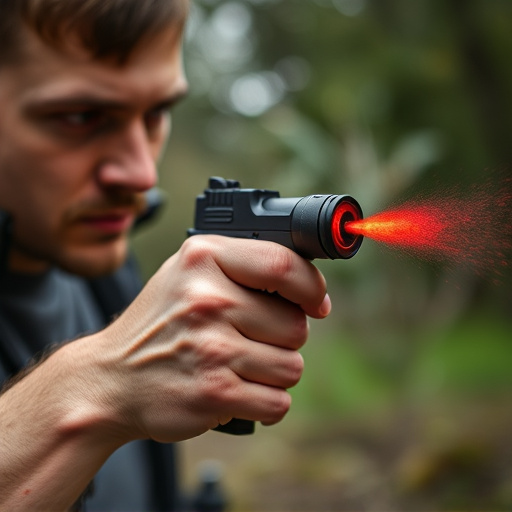Pepper spray, an oleoresin capsicum (OC) spray, is a non-lethal crowd control agent used globally by law enforcement. Its primary active ingredient, capsaicin, causes temporary blindness, excessive tearing, coughing, and breathing difficulties, lasting 2 to 15 minutes, or up to an hour in severe cases. Understanding the duration of pepper spray effects is crucial for officers to balance crowd control with minimizing health risks. Responsible use requires proper training and safety protocols to avoid prolonged suffering or lasting harm.
Police often deploy pepper spray as a non-lethal crowd control measure, but what exactly is this substance and how does it impact individuals? This article delves into the world of pepper spray, exploring its composition, mechanism, and primary use in law enforcement. We analyze the duration of its effects, offering insights into how long pepper spray can incapacitate an individual. Additionally, we discuss safety precautions and potential side effects associated with this controversial tool, providing a comprehensive understanding of its role in modern crowd control tactics.
- Understanding Pepper Spray: Composition and Mechanism
- The Role of Pepper Spray in Crowd Control
- Duration of Effects: How Long Does it Last?
- Safety Precautions and Potential Side Effects
Understanding Pepper Spray: Composition and Mechanism
Pepper spray, officially known as oleoresin capsicum (OC) spray, is a non-lethal crowd control agent used by law enforcement agencies worldwide. Its primary active ingredient is capsaicin, the same compound that gives chili peppers their heat. When sprayed, capsaicin comes into contact with the eyes and respiratory system, causing intense irritation and temporary incapacitation.
The effects of pepper spray typically last between 2 to 15 minutes, depending on various factors such as concentration, weather conditions, and individual sensitivity. During this period, individuals affected may experience tearing, redness, burning sensation in the eyes, difficulty breathing, coughing, and pain in the nose and throat. These symptoms can significantly impair an individual’s ability to resist or evade arrest, making pepper spray a powerful yet controlled tool in crowd control scenarios.
The Role of Pepper Spray in Crowd Control
Pepper spray, a potent chemical agent, plays a significant role in crowd control strategies employed by law enforcement agencies worldwide. Its primary function is to temporarily incapacitate individuals, providing officers with time and space to manage potentially volatile situations. When deployed, pepper spray disrupts the normal functioning of the eyes, nose, and respiratory system, leading to temporary blindness, excessive tearing, coughing, and difficulty breathing.
The duration of its effects varies, but on average, pepper spray can remain active for approximately 2-5 minutes. This time frame is crucial as it allows officers to control agitated or aggressive crowds while minimizing the risk of prolonged exposure that could lead to more severe health complications. The duration also depends on factors such as the concentration of capsaicin (the active ingredient), weather conditions, and individual sensitivity.
Duration of Effects: How Long Does it Last?
The duration of pepper spray effects can vary depending on several factors, including the concentration of capsaicin (the active ingredient), weather conditions, and individual sensitivity. Typically, the effects of pepper spray are intended to be temporary, lasting anywhere from 15 minutes to an hour. During this time, individuals affected will experience irritation and discomfort in their eyes, nose, and throat, along with difficulty breathing and reduced visibility.
In more severe cases or higher concentrations, symptoms may persist for up to two hours or longer. It’s important to note that even after the immediate effects wear off, residual irritation can last for several days. This is why it’s crucial for law enforcement to use pepper spray responsibly and only when necessary, ensuring public safety without causing prolonged suffering or lasting harm.
Safety Precautions and Potential Side Effects
Pepper spray, a common crowd control tool used by law enforcement, can be effective in de-escalating situations but also comes with safety precautions and potential side effects. When deployed, pepper spray causes temporary physical discomfort and sensory disruption, enabling officers to gain control and ensure safety. However, it’s crucial for users to understand the duration of its effects. The impact typically lasts between 20 minutes and an hour, though this can vary based on factors like concentration, weather conditions, and individual sensitivity.
While pepper spray is designed to be non-lethal, it can still lead to adverse reactions in certain individuals. These may include respiratory distress, nausea, dizziness, and temporary blindness. Therefore, proper training and safety protocols are essential for officers to ensure they use it responsibly and minimize risks to both the public and themselves.
In conclusion, while pepper spray serves as a valuable tool in crowd control, understanding its composition, mechanism, and potential side effects is crucial. The duration of its effects varies, with reports indicating it can last from 30 seconds to several minutes. However, proper safety precautions must be taken to mitigate risks and ensure the well-being of both law enforcement and civilians. By carefully considering these factors, we can navigate crowd control scenarios more effectively and safely.
